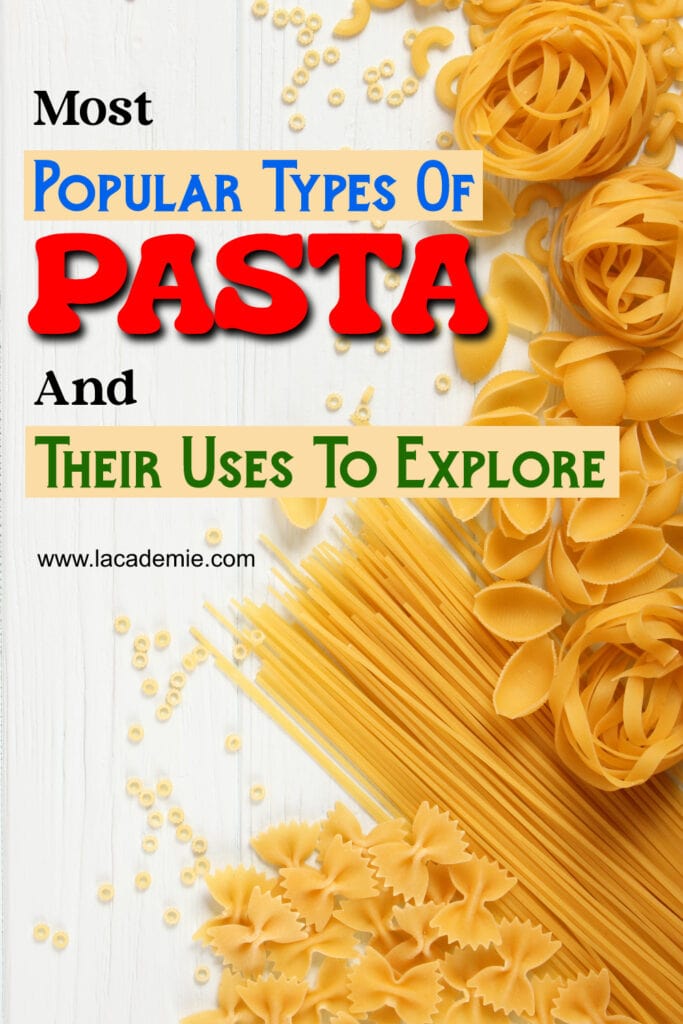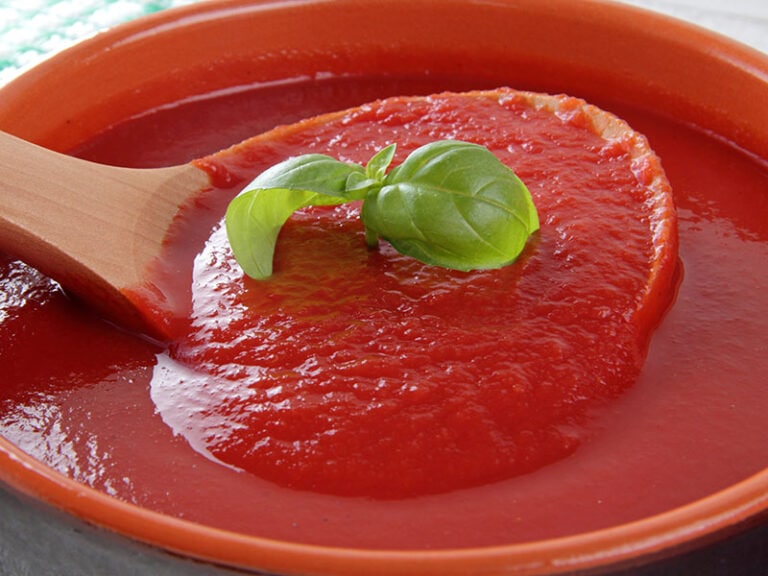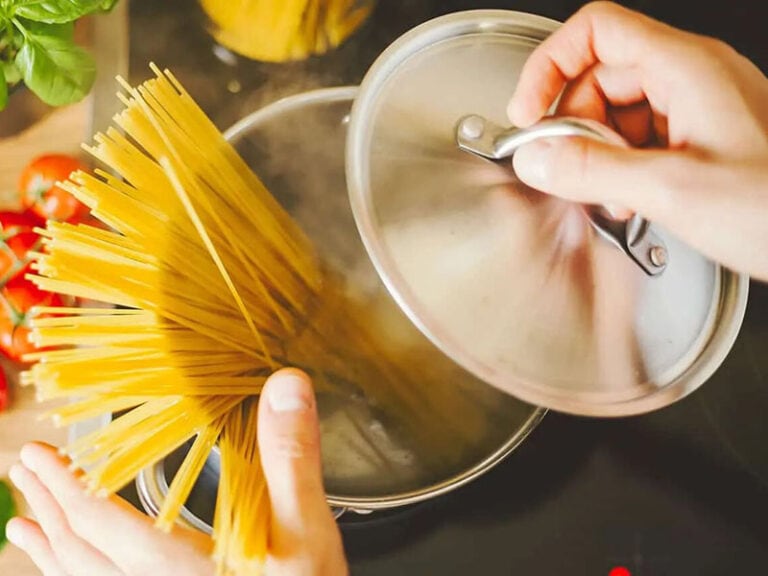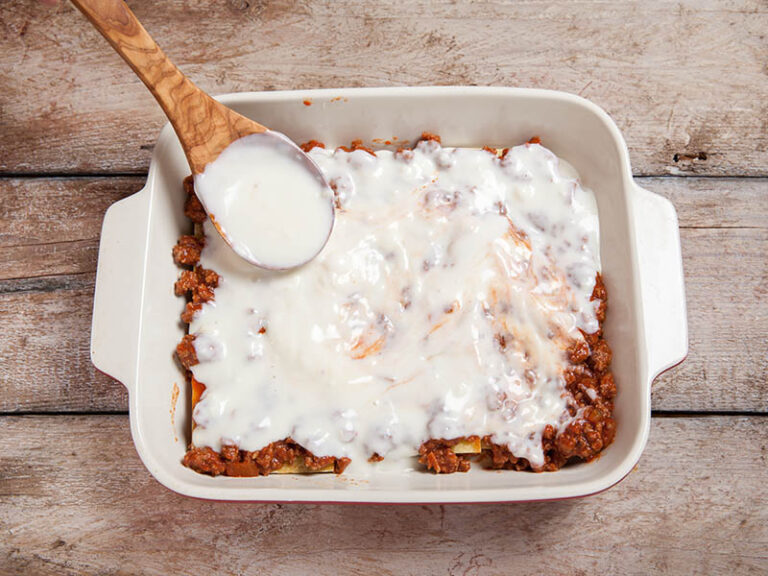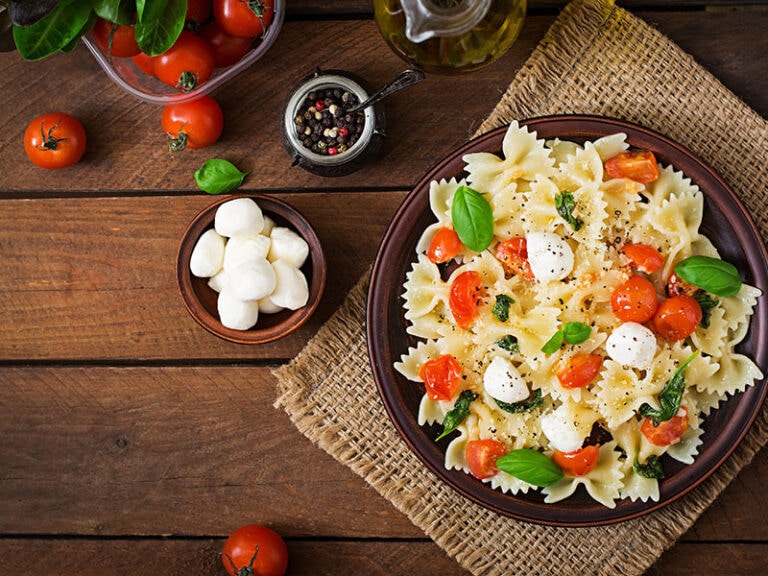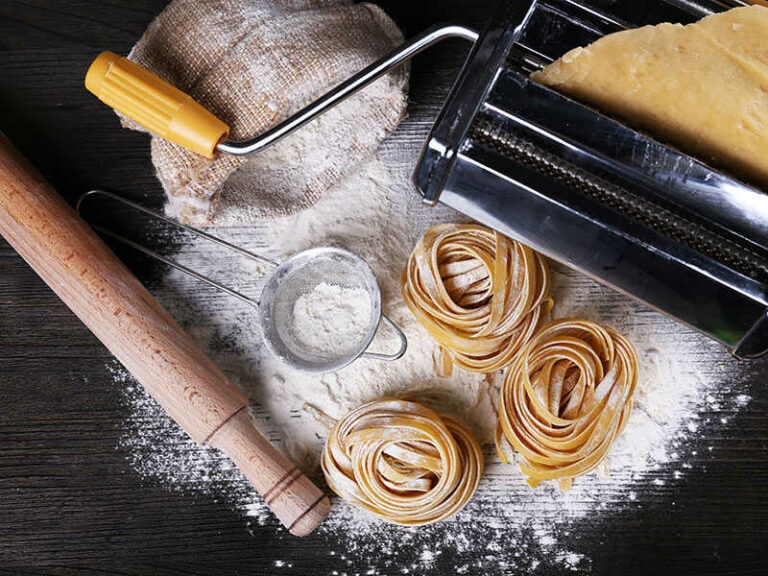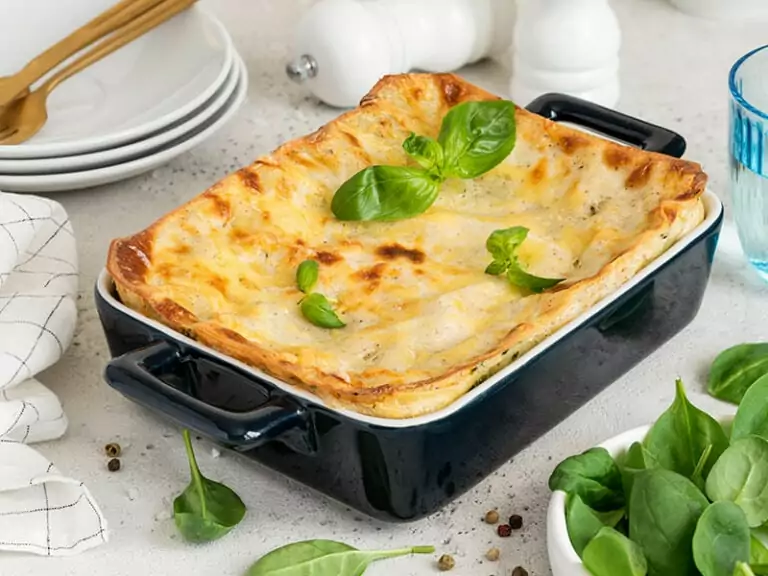Do you want to diversify your knowledge about types of pasta? If your answer is yes, I guarantee you will gain many impressions of this staple food after reading this post.
Apparently, this Italian-based food is not only about spaghetti, fettuccine, or penne. So how many pasta variants are there?
There are around 350 different pasta noodle sorts with distinctive shapes. Some even say these foods’ starting letters in their names can range from a to z.
But this post only covers the 36 most popular types in separate categories based on their characteristics, including long, medium, and short pasta, pasta with filling, soup pasta, and stretched pasta.
Let’s begin this post with a short overview of pasta regarding its history, ingredients, and other insights. Check it out, everybody!
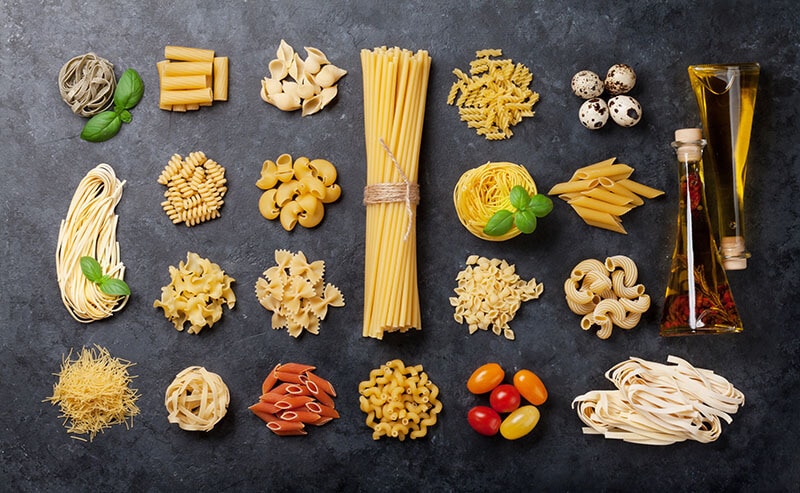
Pasta – A Century-Old Food That Everyone Loves
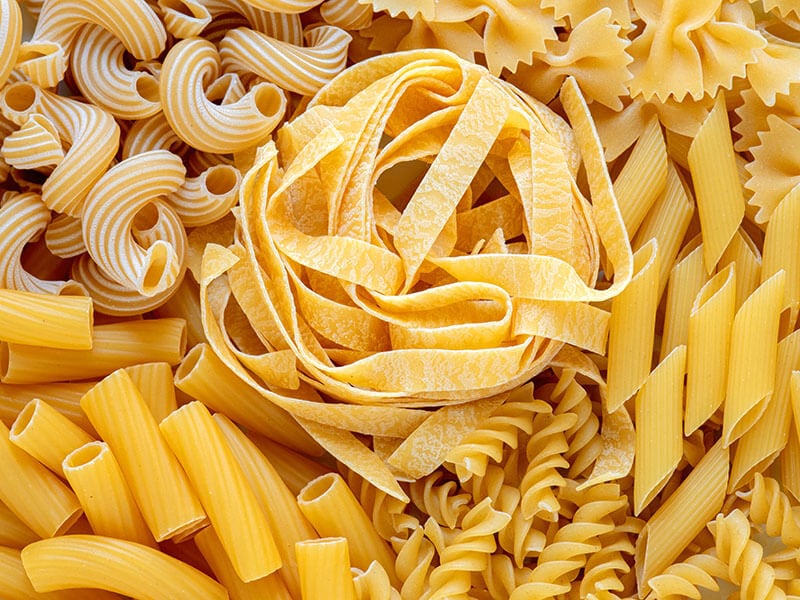
It is clear to see that pasta is a staple food in Italian cuisine. This is a generic term for food made with unleavened dough shaped into plenty of forms (around 310 forms).
There are 2 main categories of pasta, including dried (commercial pasta produced by extrusion tools) and fresh pasta (hand-made varieties or by simple machine).
Different types of pasta have different ways to prepare dishes, such as with sauce or condiment, in soup, or in baked treats.
So if you want to know more about them, the next part will open your mind regarding this amazing food.
This animated video provides a better way to learn about pasta history.
In this section, you will discover 35 types of pasta in 4 distinctive parts. The most common types are those that have long and medium-lengths. The classic example is spaghetti, but there is so much more. Keep reading to explore!
12 Long and Medium-Length Pasta
Long and medium pasta refers to their length. People can make them by rolling and cutting or with the help of extrusion tools.
Therefore, they might have a thin flat shape and come in a strip-like appearance, while some pasta styles have thicker strand pasta shapes.
These types are ideal for pairing with various pasta sauces, especially cream or thick sauces. For a quick review, you can check the below table with brief information.
1. Spaghetti
Cooking time: 8 to 12 minutes
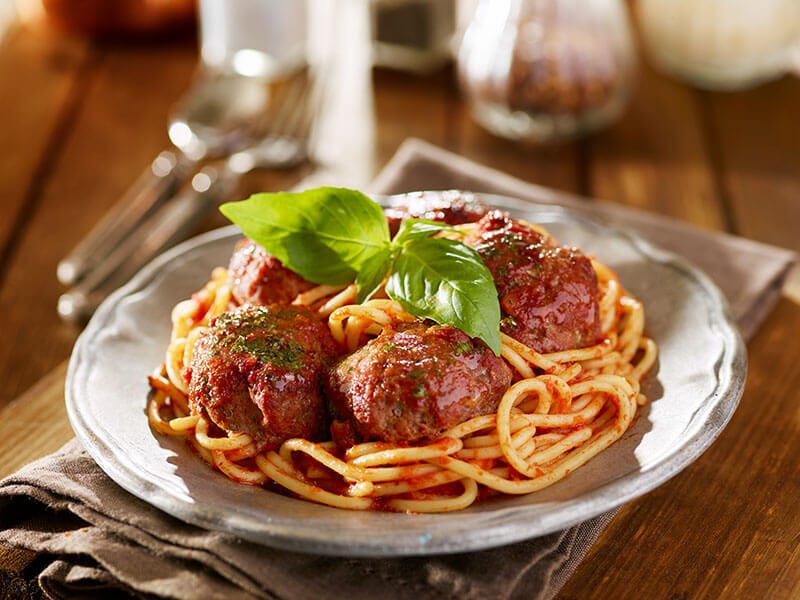
The most basic pasta is the long spaghetti in the shape of a cylinder. They are neither too thick nor too thin, making them ideal to go with meaty sauces, cream sauces, or some lighter sauces made from garlic and olive oil.
And it would be better if you use a spaghetti fork – a 3 or 4-tined fork style to eat this pasta easily and properly.
The typical ingredients for spaghetti are milled wheat and water. In contrast, Italian-authentic spaghetti might be made with durum wheat semolina. Furthermore, spaghetti length is between 10 and12 inches (25 to 30 cm).
This pasta can be either in dried or fresh form. Regardless of their form, you will need a large and high-quality pot to cook pasta with a bit of salt and water, then use a colander to drain them before mixing with sauces. For more convenience, you can buy a spaghetti scoop or tongs.
The appropriate time to cook this pasta is from 8 to 12 minutes. A perfectly-cooked spaghetti must be firm and chewy. You can cook them a little longer for a softer texture. However, do not let them overcook to avoid too-soft pasta.
How do they make the top-rated quality spaghetti? Click here to explore!
2. Capellini
Cooking time: Around 4 minutes
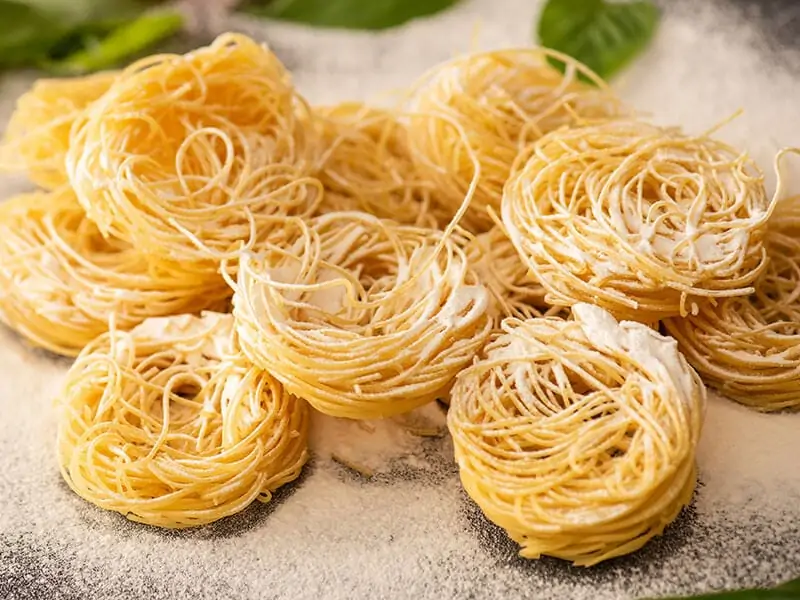
Capellini (meaning “little hairs” in Italian) is a skinny version of spaghetti. The diameter of them ranges from 0.033 to 0.036 inches. Therefore, cooking capellini only takes a few minutes.
Flour, eggs, and salt are the main components of capellini. After cooking, they feature a delicate texture that you should toss with light sauces, soup, seafood, or veggies. If desired, you can pair it with your cold salad.
Additionally, there is a thinner version of capellini called Capelli d’angelo (aka angel hair pasta) with only 0.035 to 0.035-inch thicknesses (0.8 and 0.9 mm). This style usually is available in a nest-like appearance. In brief, these are the thinnest pasta in the long-pasta category.
3. Vermicelli
Cooking time: 5 to 7 minutes
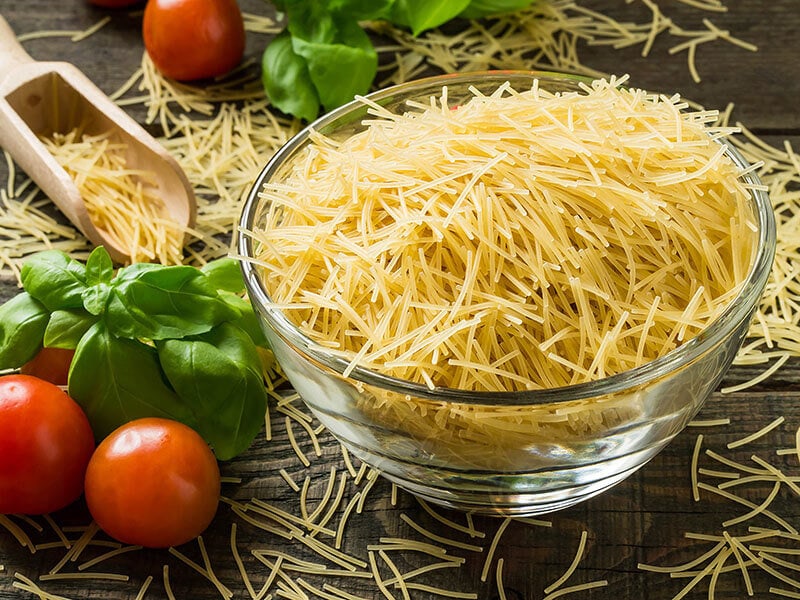
First, do not mistake this one with other rice vermicelli noodles in Asian cuisine as there are many differences between noodles and pasta that you should know. In this case, Italian vermicelli is made from semolina, while Asian ones are rice-based noodles.
Overall, vermicelli (its moniker is “little worms”) is a yellow, round, and long pasta that shares a similar look to spaghetti. Actually, the thickness of these vermicelli varies based on their regions.
For example, they are regularly thicker than spaghetti in Italy while thinner in other English-speaking countries. So the thickness might range from 0.082 to 0.091 inches (2.08 and 2.30 mm).
As a skinny type of pasta, vermicelli is best suited to light dressing or sauce like olive oil-based or tomato sauces.
4. Bucatini
Cooking time: Averagely 9 minutes
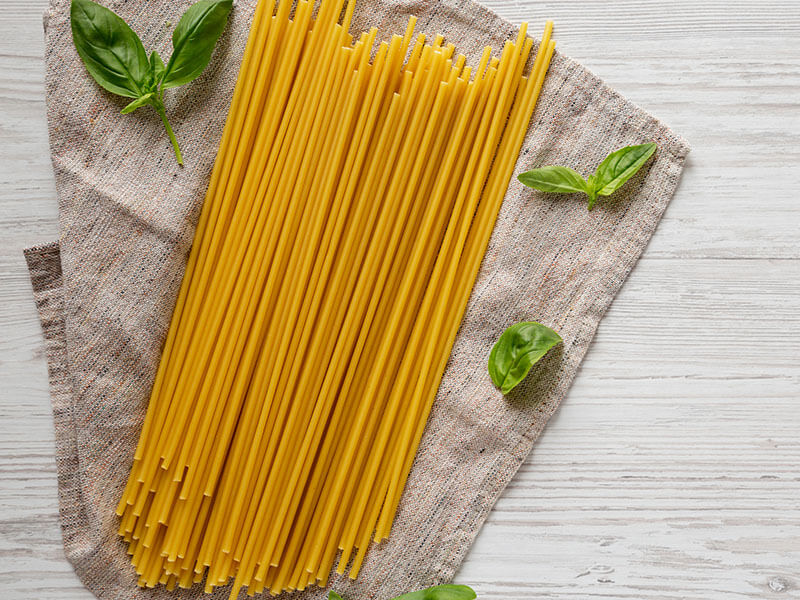
Bucatini is quite versatile. In Italian culinary culture, they are perfect for a buttery sauce like Amatriciana sauce, in casseroles or soup, or with eggs, vegetables, cheese, or seafood. If possible, prepare some side orders to go with your pasta to make your meal more fulfilling.
At first glance, they might look like classic spaghetti, except they are more round in shape with a hole in the center. So generally, this is a hollow-tube-style pasta. Actually, the name “bucatini” derives from the word “buco” (which means “hole”).
Like other varieties, durum wheat and water are what people use to create bucatini. The typical diameter is around 1/8 inches and from 10 to 12 inches. If you want to make them at home, a pasta machine is not suitable for this style as it should be extruded, not rolled.
5. Tagliatelle
Cooking time: 7 to 10 minutes
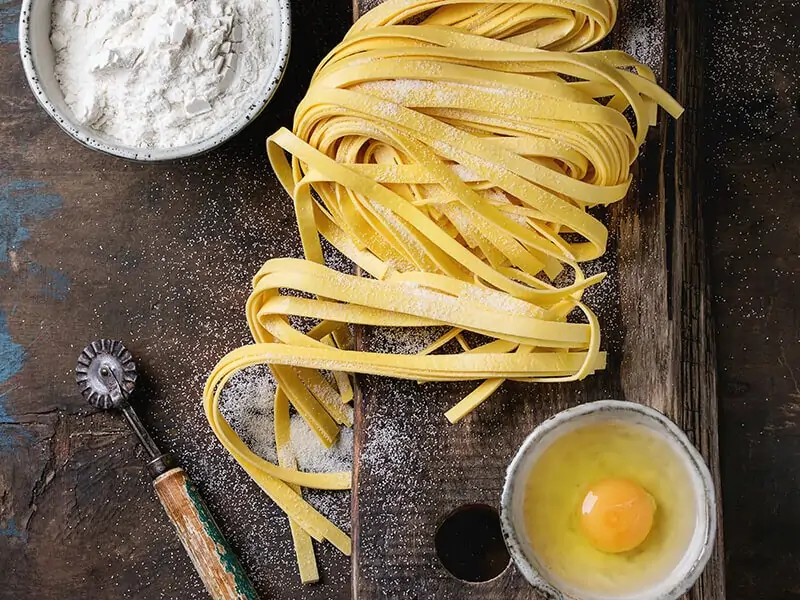
In Italian, Tagliatelle is “to cut” to indicate the way people prepare it by hand. First, they will roll the dough into a flat sheet and then cut it into long, thin strips (similar to fettuccine).
Therefore, this pasta has a porous and tougher texture that you can mix with thick meaty sauces, like Bolognese sauce.
They can be beef, pork, or veal-based sauces. For more information, the locals in northern Italy usually eat it with meat ragù. Or, if you prefer lighter ones (for vegetarian diets), tagliatelle is also a perfect style to enjoy with basil and tomato sauces.
Moreover, this is an egg-based pasta that you can apply to the ratio of 100 grams of flour for 1 egg. And the authentic tagliatelle has to be around 1/4-inch width (6 mm).
6. Fettuccine
Cooking time: 8 to 13 minutes
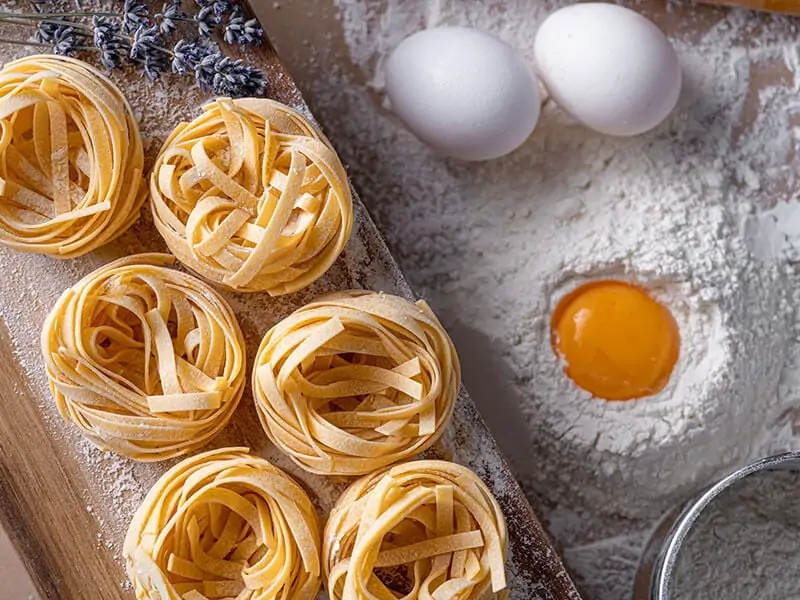
Fettuccine is a long-length pasta with a flat and thick-ribbon shape. The first thing to notice about this pasta is fettuccine is wider compared to many other pasta varieties.
Actually, there are 2 monikers to refer to this pasta, including fettucce and fettuccelle. But fettucce is a wider one with around 0.5-inch width, while fettuccelle is narrower with around ⅛ inches in width.
The primary ingredients to make fettuccine are eggs and flour. They own an eggy flavor that can combine with creamy or chunky sauce to become a mouthwatering duo. Enjoying it with meat is also preferable, like in beef or chicken ragù.
Fettuccine is available in fresh (traditionally) and dried forms. In short, this is one of the most common pasta kinds around the world, especially in Roman and Tuscan delicacies.
3 fantastic ways to upgrade normal fettuccine to fine-dining dishes.
7. Linguine
Cooking time: 9 to 13 minutes
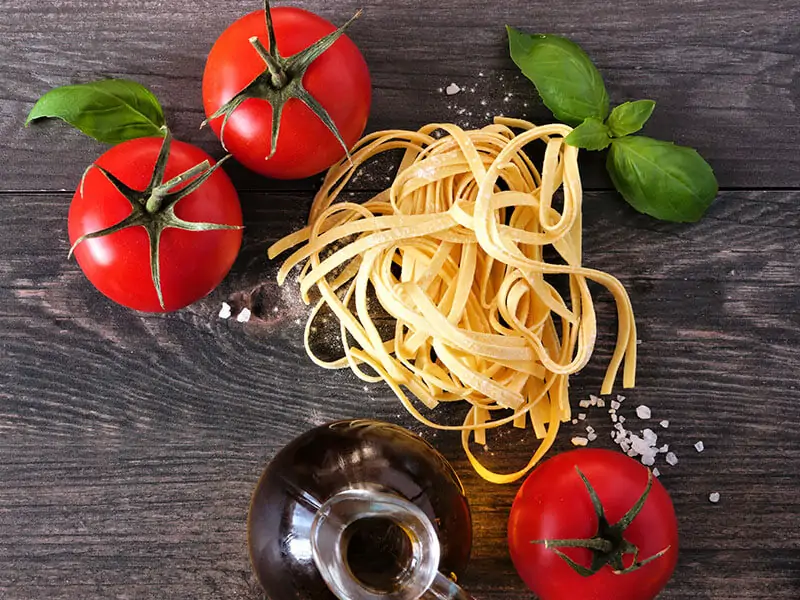
It might be challenging to differentiate between linguine and fettuccine if you are new to pasta. So just remember: linguine is not as broad as fettuccine, and its section is quite elliptical (not flat like fettuccine).
The standard width of this variety is approximately 5/32 inches (4 mm), and it is slightly thicker compared to the traditional spaghetti. There is also a skinnier version named linguettine that you find in the supermarket.
People usually eat linguine with seafood (e.g., mussels, clams, prawns, etc.) or any creamy- or fish-based sauces. Pesto sauce or any tomato-style sauce is also an excellent companion to this pasta.
8. Pappardelle
Cooking time: 7 to 10 minutes
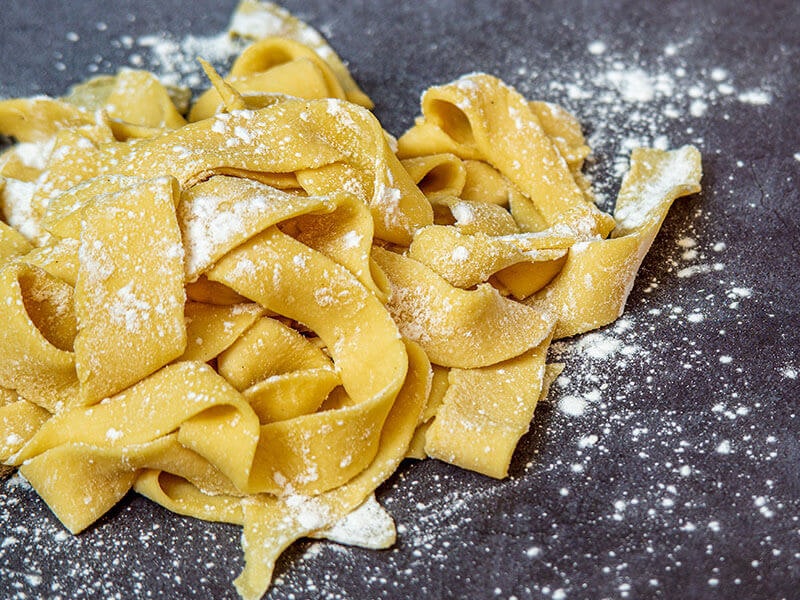
This pasta is one of the broadest types that can reach from 3/4 to 1 inch (2 to 3 cm) in the style of long ribbons. It is a very wide pasta with a flat shape and is usually sold as fresh pasta.
There is a minor difference between fresh and dried pappardelle as the latter has straight edges, while the latter’s sides are more fluted.
People generally serve pappardelle with heavy meaty sauces since its root is from Tuscany – a famous place for various rich sauces made with meat. Ideally, these sauces could be ragù or bolognese. Or, if you love seafood, pappardelle is also a great choice.
Fun fact: Pappardelle comes from the word “pappare” (meaing “gobbling up” in Italian).
9. Lasagne
Cooking time: 11 to 15 minutes
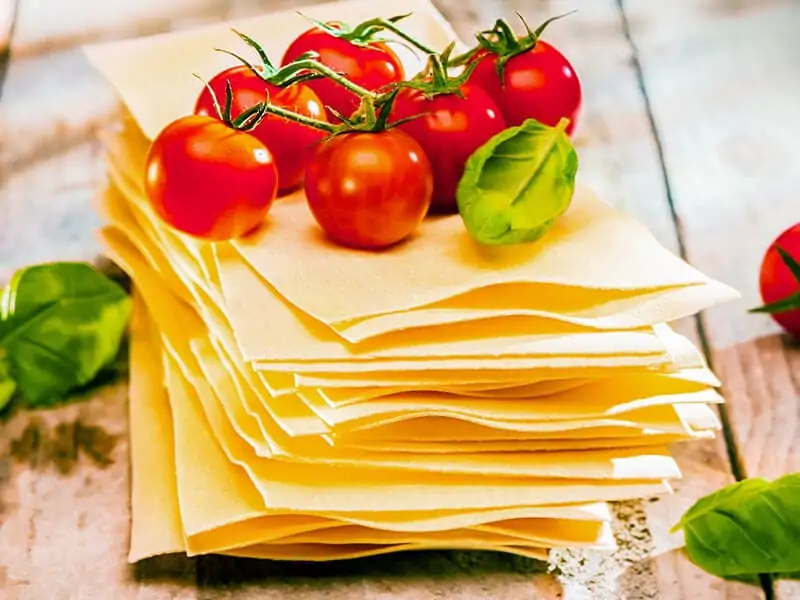
Speaking of lasagne, it is the plural form of lasagna that you can use to refer to an authentic Italian dish containing layers of meat, tomato sauce, cheese, and wide pasta strips. And do you know it is one of the oldest types of pasta?
The exact root of lasagne is unclear as there are different myths related to its origin. The first recipe that has similarities to modern lasagne appeared in a cookbook in the 14th century.
With an unusual large width, lasagne is simple to spot among other kinds. Most of them come in flat sheets, while some versions have ruffled edges or ridged surfaces. The way to make this pasta is also different based on where they are made.
For instance, people in southern Italy do not use eggs to make these sheets, whereas it is an egg-based pasta in northern areas. You can consume it with meat or veggie-style ragù. In case you do not have cannelloni on hand, rolling lasagne sheets into cylindrical tubes are ideal replacements.
10. Ziti
Cooking time: 9 to 15 minutes
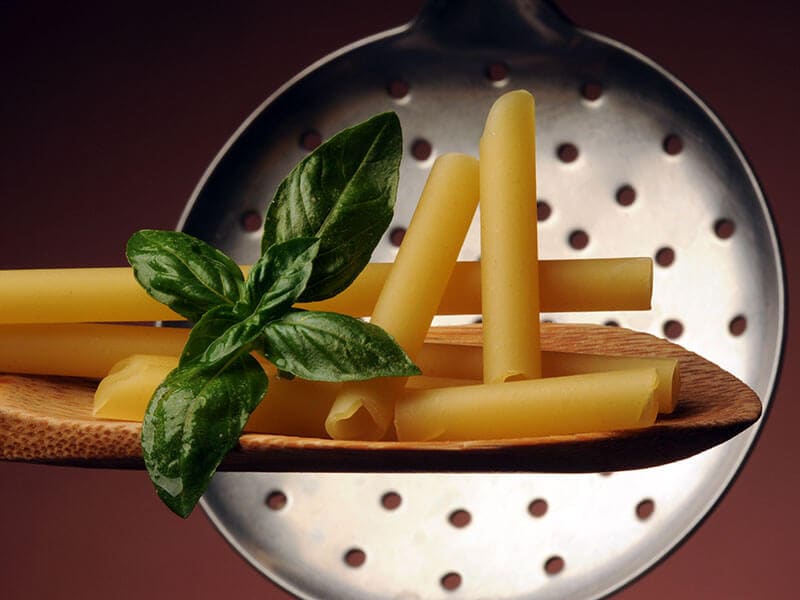
Ziti is a specialty of Campania – an administrative area in Italy. This is a tubular pasta with a medium length. They are somehow similar to penne; however, there are many facets to differentiate ziti and penne.
Give them a close look; you can see their cut shape differently. Ziti has square edges, making them look longer. In addition, ziti typically has a smooth exterior. In the beginning, they are a long and wide tube (about 25-cm in length), then cut into shorter pieces (around 2 inches).
Regarding its culinary purpose, ziti is most famous for baked ziti – a well-loved dish in Italian-American cuisine. They can go both with creamy or light sauces. However, the former is better.
It is also an excellent component for making casserole dishes. If desired, you can stuff them as well. And in Sicily (an Italian region), ziti is best served at weddings. In fact, “zito” – the singular of “ziti” means “groom and bride” in the Sicilian language.
11. Penne
Cooking time: 10 to 13 minutes
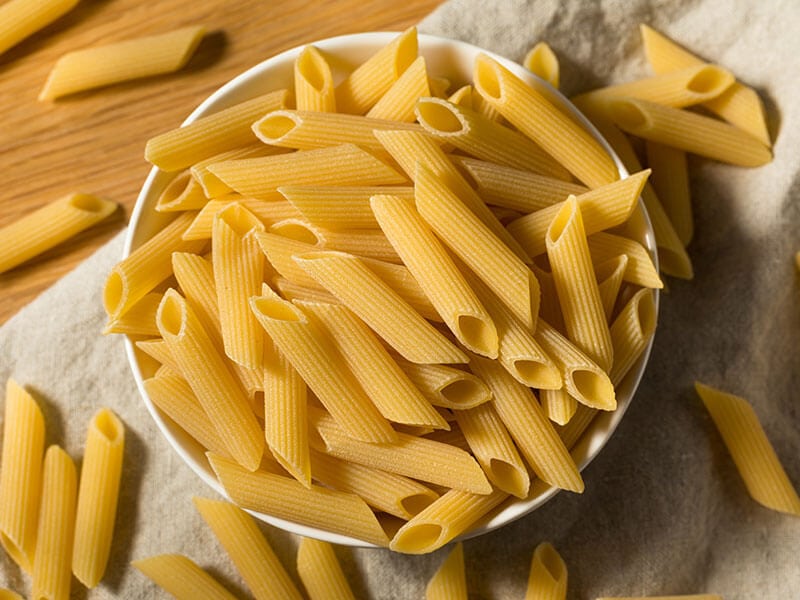
The last pasta in this group is penne. It is an extruded pasta with 2 main styles: penne lisce (smooth surface) and penne rigate (ridged surface). Moreover, if you need a wider version of penne, you can use pennoni.
Let’s talk a bit about its history. Unlike other pasta with unknown origins, penne was an invention of Giovanni B. Capurro – a pasta maker, in 1865. He cut fresh pasta into smaller pen-shaped pieces, ranging from 1 inch (for mezze penne/half pens) to 2 inches (for penne/pens).
Furthermore, it is hard to see the big gap between the lengths of penne and ziti, so the only way to recognize them is penne’s end to be cut at an angle.
For cooking, the best way to enjoy penne is to combine it with tomato-based sauces, like arrabbiata, pesto, or marinara. Penne is also a good combo with meat sauce.
Do not know how to make penne from scratch? This instruction will show you some tips.
12. Gemelli
Cooking time: Around 8 minutes
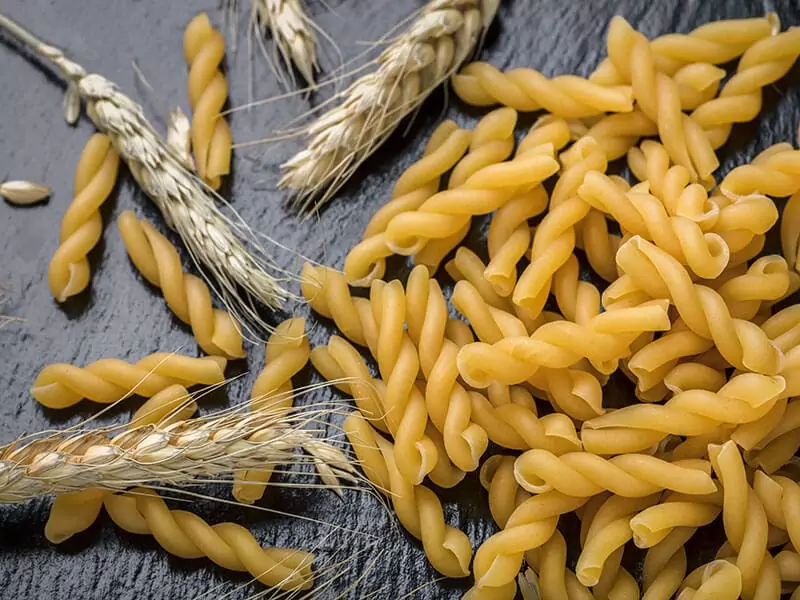
In the Italian language, the term “gemelli” stems from the word meaning “twins”. However, do not assume this pasta type features twin twisted tubes like its appearance. Instead, gemelli is a twisted single strand that looks like a spiral.
The size is from 2 to 3 inches (50 to 80 mm). It is a small pasta type that you can use in many recipes, including pasta salad, casserole, or other saucy dishes.
Indeed, with its special shape, the pasta can hold the sauce beautifully yet still retain a perfect firm al dente texture after cooking.
How Many Short Pasta Are There?
There are 10 main types of short pasta. Here are the most popular ones worldwide that you should learn first:
13. Rigatoni
Cooking time: 10 to 15 minutes
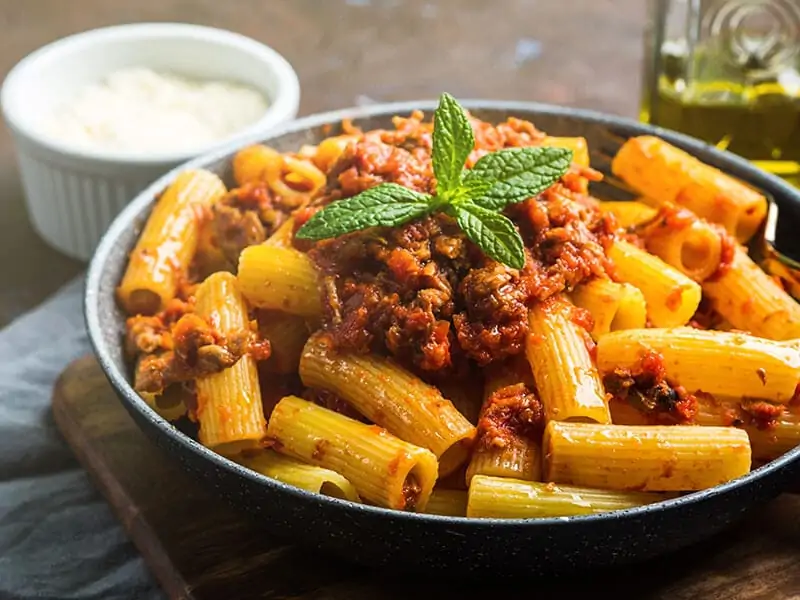
Rigatoni is a close cousin of penne as it also comes in a tube-shaped pasta with a ridged surface. The name “rigatoni” is from the word “rigato”, meaning lined or ridged in Italian.
However, compared to penne, it is shorter in length and has no pointy end. Rigatoni is also bigger and not-too-narrow in appearance. Thanks to their larger hole in the center, this pasta variety is perfect for holding the sauce or small pieces of meat.
Rigatoni works excellently in baked food without turning mushy. So please feel free to use it in your favorite casserole. Imagine a bite full of meat, sauce, and cheese with this pasta. So yummy, right?
14. Macaroni
Cooking time: 9 to 12 minutes
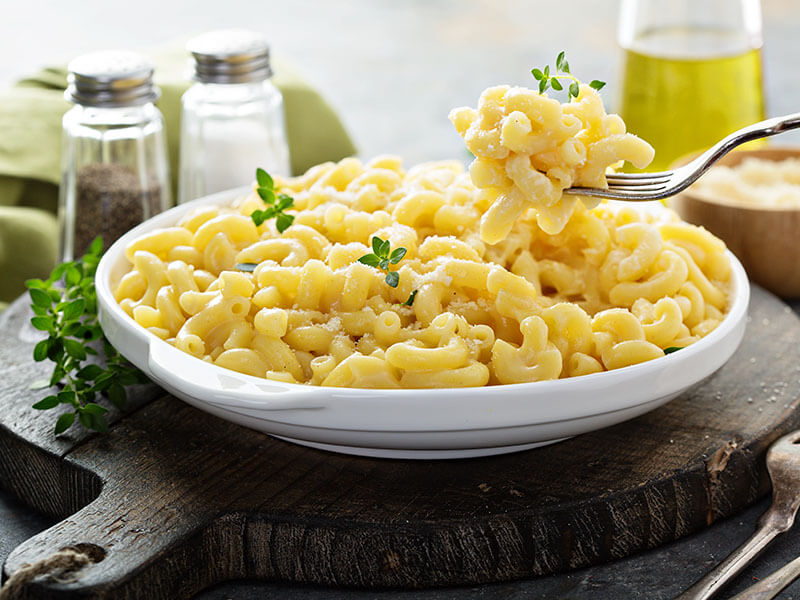
This is a dried pasta that you can find in most mac and cheese recipes. And yes, mac is the shorter way to call macaroni, but the macaroni in these treats are elbow-shaped ones, while there are other straight and tubular versions called maccheroni.
These are narrow-tubed pasta that humans use durum wheat to prepare, resulting in a thicker and more resilient pasta. They can be made in a home pasta machine or commercial extrusion tools.
In cooking ideas, besides mac and cheese, macaroni is an amazing addition to salads or other creamy casseroles. These hollow tubes can trap the sauce well, improving the pleasantness of every single bite.
15. Gnocchi
Cooking time: 2 to 5 minutes
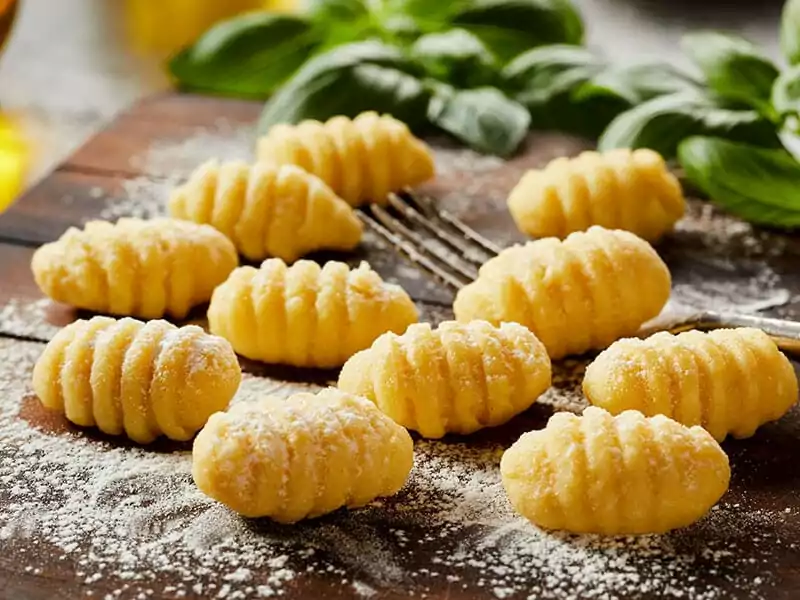
Gnocchi – an exotic food starting with a G letter, also falls under the dumpling category in Italian culinary practices, but most of all, people mainly recognize it as a type of pasta. First, they have a unique look as small dough lumps.
The components in gnocchi are more complicated than others. They contain wheat flour, semolina, potatoes, and more. That’s why they own a dense and chewy texture and are shaped into small dumplings.
You can make gnocchi at home and consume it on the same day you prepare these small dumplings. Or for easier preparation, gnocchi is also available at stores. But once opened, they must be stored in the fridge.
For the best meals, smother them in a rich creamy sauce. Or lighter sauces like herb or tomato sauces also work fine with this pasta variety.
Here are some insights about gnocchi’s origin that you should know.
16. Paccheri
Cooking time: 7 to 10 minutes
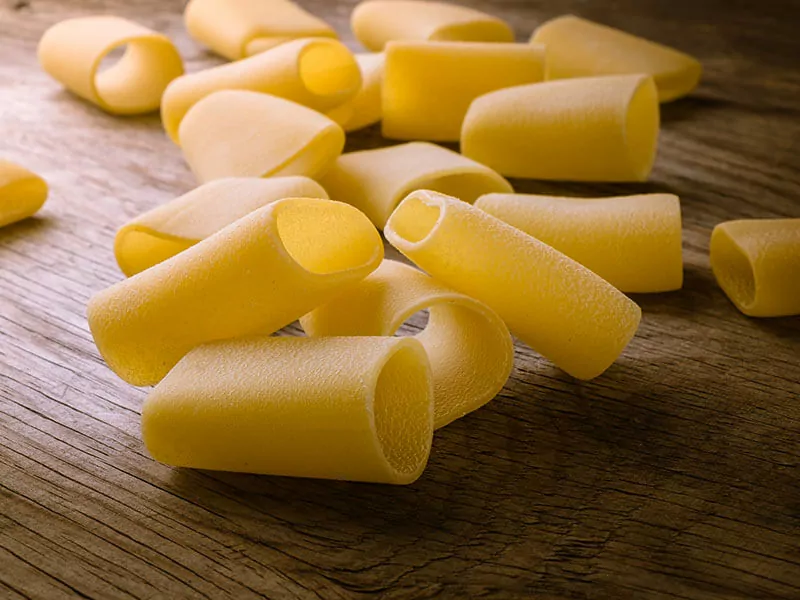
Like ziti, paccheri originates from Campania. They are a distinguishing pasta with a very large diameter with a big hole in the center. In contrast, paccheri is shorter in length than previous ones.
As they feature pasta with a very large-tubed shape, you can unstuff or stuff them with other ingredients (like cheese) when cooking. Besides, their surface is relatively smooth, but you can spot some variants with ribbed surfaces as well. However, the smooth version is more common.
These short tubes are delicious when mixed with heavy or garlicky sauces. Using it to create seafood delicacies (e.g., lobster, shrimp) or meaty chunky sauce like bolognese is another great solution.
Quick fact: This pasta’s name derives from the word “paccharia” (meaning “slap” in Neapolitan language) to indicate the slapping sound when you eat them.
17. Conchiglie
Cooking time: 10 to 12 minutes
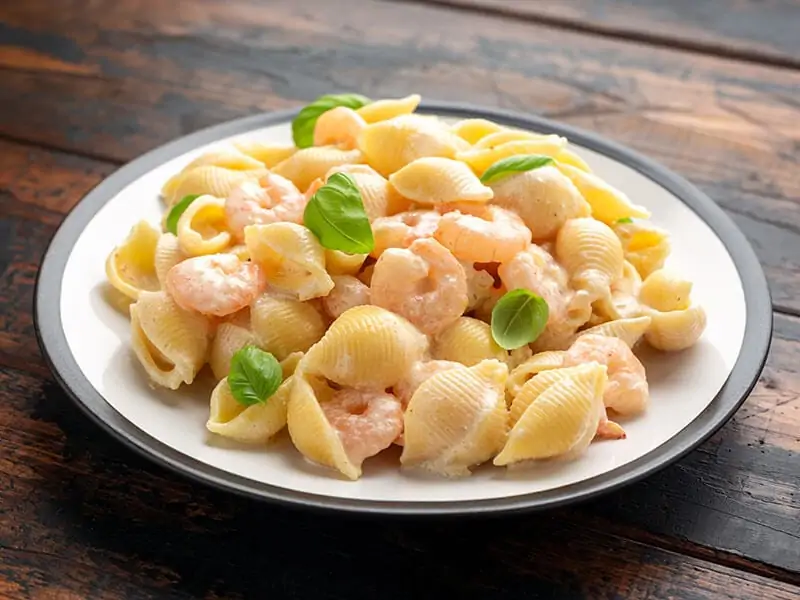
Here is another common style that has a shell-like appearance. That’s why they are more prevalent under the name shell pasta rather than conchiglie. Plus, its name comes from the word “conchiglia” ( seashell in Italian).
The basic style of conchiglie is the plain one consisting of durum wheat with typical pale yellow color. However, they are also available in other colors from natural pigments (e.g., spinach or tomato extract, or squid ink).
Conchiglie also comes in various sizes, from mini to jumbo, but they are still under the short-cut pasta. Thanks to their special shape with an opening center, they can lock any sauce excellently. Whether it is for soup, stew, or casseroles, I believe conchiglie can satisfy you.
18. Cavatelli
Cooking time: 2 to 3 minutes (or more if they are frozen)
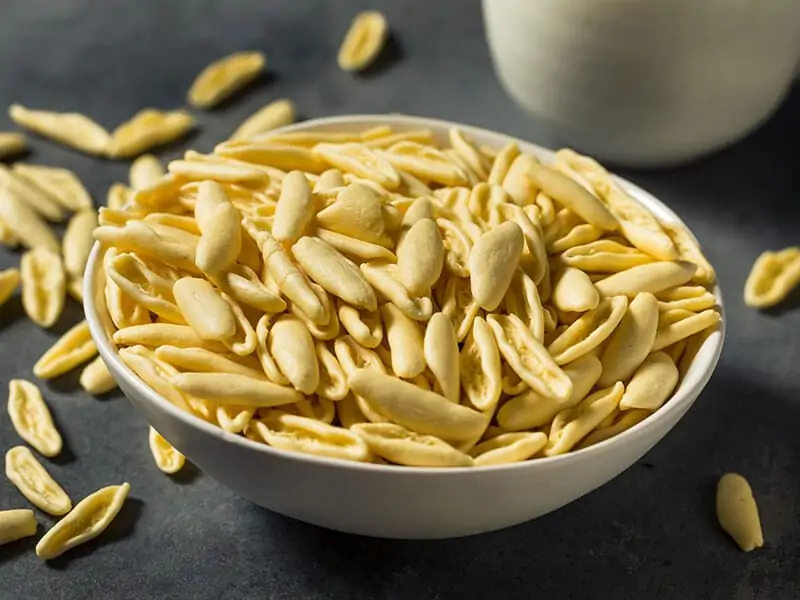
Cavatelli has an odd shape that might look like miniature hot dog buns. Their texture is chewier and denser than other egg-styled pasta. What’s more, you can make them from scratch without a machine.
Indeed, these are one of the easiest homemade pasta. Cavatelli contains semolina (or other flours) and water, then hand-shaped into small pieces by using some familiar kitchen utensils.
You can add ricotta to the dough mixture if you want to enhance the overall flavor of your pasta. Plus, the most common way to cook this pasta is with the addition of garlic or broccoli, or enjoy it with your favorite sauce.
19. Cavatappi
Cooking time: 9 to 10 minutes
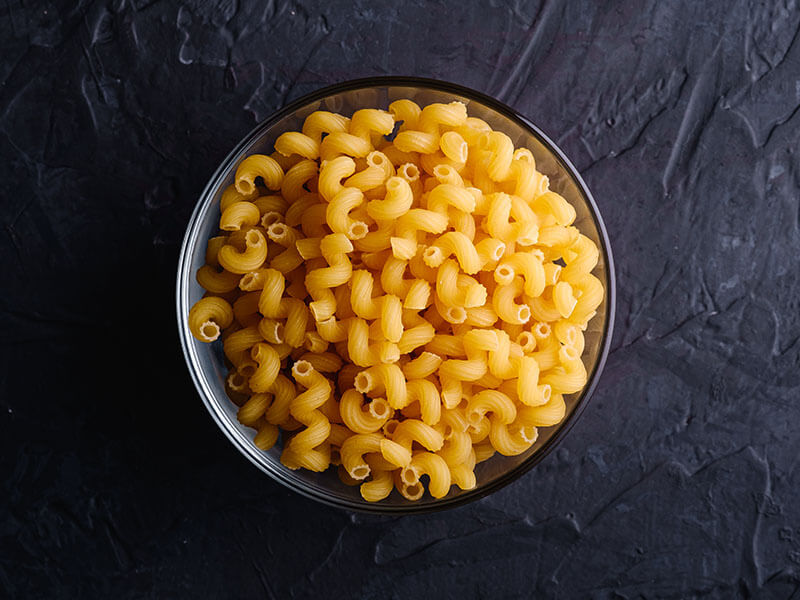
It is true that sometimes you can hardly tell cavatappi and macaroni apart, but let me tell you how to distinguish them. They are both tubular but look closer; you can see cavatappi is more like a helix with double (or triple) elbow-twisted, whereas elbow macaroni only has one twist.
Furthermore, they also have ridged surfaces extruded from a pasta maker. Actually, it is a subclass of macaroni with a thick texture. They might be yellow or in other colors (like red or green).
Cavatappi is a versatile type as they can go with various dishes, such as casseroles, salads, or even soups. As a close cousin of elbow macaroni, using this pasta style in making mac and cheese is also a suitable option. Of course, it is still a good ingredient to mix with tomato sauces.
20. Fusilli
Cooking time: 10 to 13 minutes
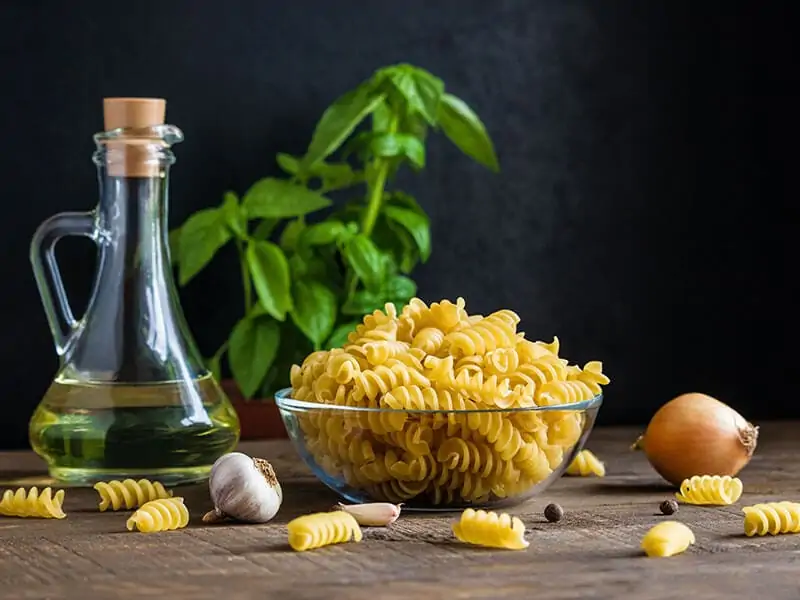
Fusilli (or rotini in America) is another unique pasta with a spiral or corkscrew shape, making it not ideal for home-making. These are thick pasta with several spiral gaps on the surface. And these gaps function well to carry thick sauces.
One more thing to prove fusilli is a challenging pasta as the gaps between spirals must be even and precise. Another interesting thing about them is their variants. They can be either hollow or solid. If they fall under the former style, their name is fusilli bucati.
There is a long version in twisted shape called fusilli lunghi. But generally, fusilli are twisted and extruded pasta that may come in traditional yellow color or other hues from other ingredients’ extract.
21. Farfalle
Cooking time: 8 to 15 minutes
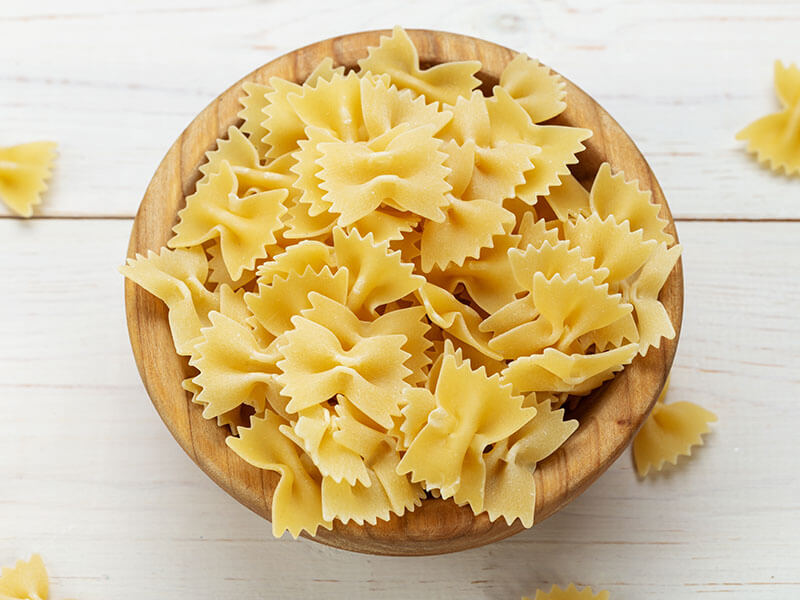
Other names of farfalle are bowtie or butterfly pasta to imply their cute appearance. No doubt it is one of the most kid-friendly varieties.
For more specific information relating to its name, in Italian, farfalle is butterflies, or in Emilia-Romagna’s local language, the natives also call them strichetti, which means “bow ties”.
The ultimate way to consume farfalle is by coating it with creamy sauces, but they are also a suitable component in many salad dishes. After cooking, baking, or reheating, they hold the shape nicely too! However, make sure that you know some tricks to reheat your pasta correctly.
Plus, please remember that the size of the farfalle varies. Most variants are smooth, but if you find it under the name “farfalle rigate”, it is the ridged version.
22. Rotelle
Cooking time: 9 to 12 minutes
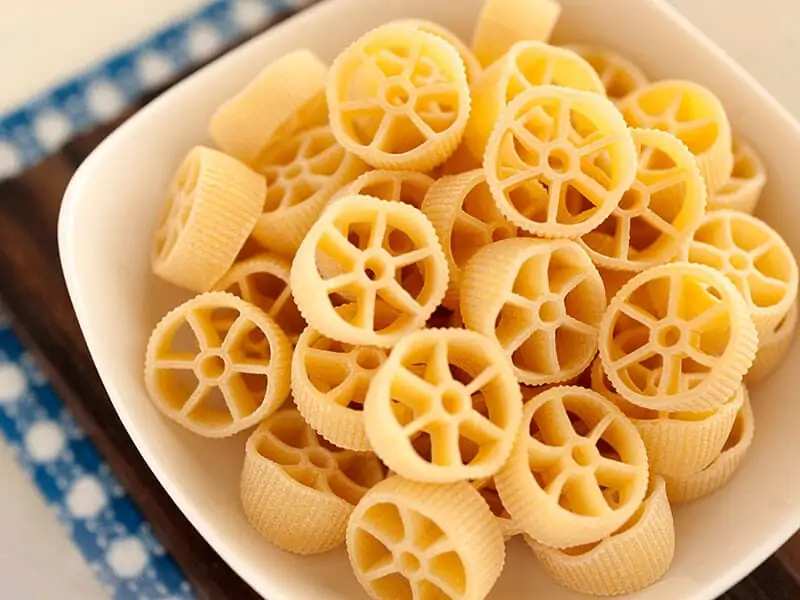
If your child is a picky eater, you can choose this pasta sort to add a little fun. Obviously, their unique shape is the first impression. The term “rotelle” implies “small wheel” to resemble their wheel-like shape. In America, people also know them as “wagon wheels” pasta.
They feature a ridged exterior and spokes inside, creating several small gaps to carry tiny meat chunks or veggies. Like most pasta here, rotelle is great to serve with heavy or thick sauces. If desired, you can still enjoy them in your salads or soups.
Regarding its ingredient, the typical food to make this fun pasta is durum wheat, but it can also contain whole wheat, quinoa, or semolina.
Besides some types with universally normal shapes, let’s see how Italians use this odd rotelle pasta.
Pasta with Filling
The general term to refer to a wide variety of filled pasta is raviolo. And as the title suggests, they come with a filling that varies in components. Here are 5 classic sorts that you need to know to create a hearty Italian dinner. And I am pretty sure they will come out ideally.
23. Cannelloni
Cooking time: 7 to 10 minutes
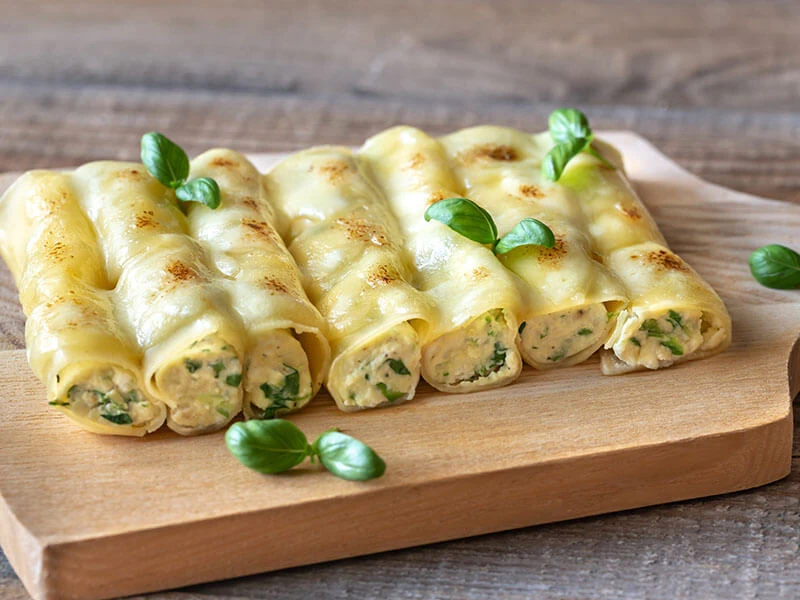
This pasta has a hollow-tubed shape that you can obtain from rolling a sheet of lasagne. So basically, they are the cylindrical style of lasagne.
With a big hole in the middle, cookers usually stuff them with minced beef, cheese, or spinach, then bake them in the oven and smother the pasta in the sauce. In reality, the way to prepare the filling are different, depending on the region.
For example, cannelloni stuffed with ham, ricotta, and mozzarella is popular in Campania, while people in the Umbria area might want to consume them with parmesan and bechamel sauce.
In the United States, manicotti is a close variant of cannelloni. The principal dissimilarities between these 2 are manicotti is ridged and relatively thicker, whereas cannelloni’s surface is smooth and thinner in texture.
Baked cannelloni for dinner is a fuss-free dish.
24. Casoncelli
Cooking time: 8 to 10 minutes (also depends on how thick they are)
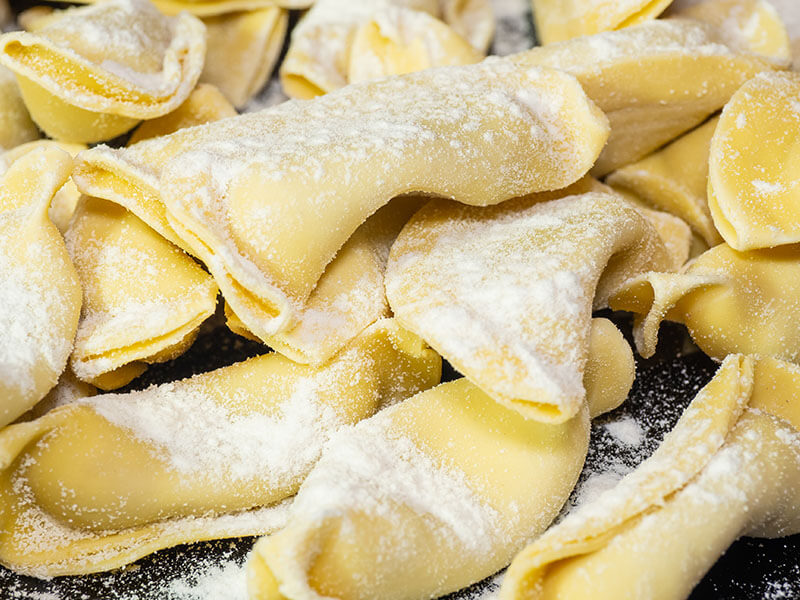
Casoncelli is stuffed pasta with various styles of filling based on its variants. For instance, in the alla bergamasca style, the filling mixture includes beef, bread crumbs, cheese, egg, etc.
Or in alla bresciana variant, the mixture contains garlic, nutmeg, cheese, bread crumbs, and herb. Moreover, the texture of these fillings is relatively coarse. The outer cover of casoncelli is 2 pasta sheets (approximately 1.6 inches) with closed edges so the filling will not spill out.
In every bite, you can feel their rich flavor that you do not even serve them with a too-creamy or heavy sauce. The ideal sauce, in this case, is a combination of sage and melted butter.
25. Ravioli
Cooking time: 4 to 9 minutes
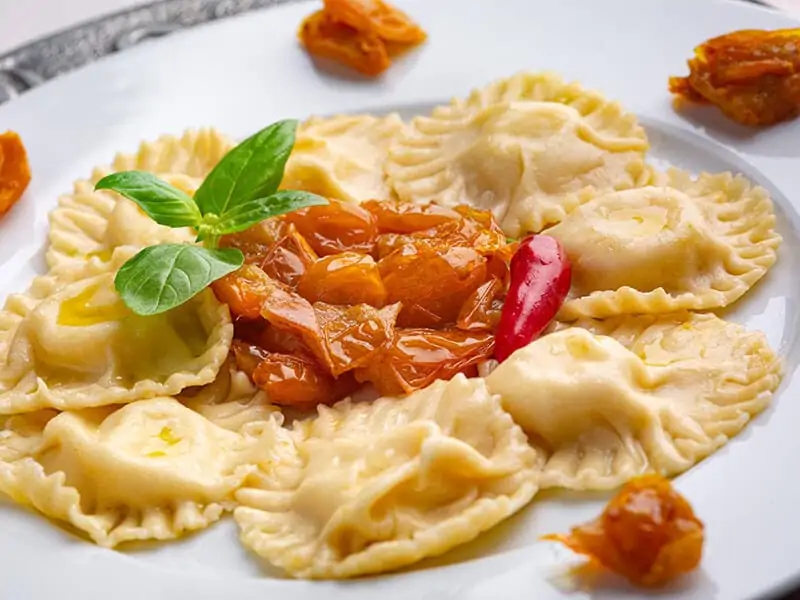
Originating from Northern and central Italy, ravioli plays an essential role in holidays, especially Christmas. They are delicate pasta filled with various components which vary according to the region where people make them.
The standard filling contains cheese, meat, and veggies. On the other hand, ravioli commonly come in a square shape, or circular to semi-circular form.
The classic ravioli are homemade ones, but the modern ravioli is mostly machine-produced, which might be a bit smaller than the homemade version.
Though they are stuffed pasta, their shelf lives are quite impressive, especially the fresh-packed form. And you can easily buy them across America and Europe. For the most delicious ravioli-based dish, you should serve them with sauce or broth.
26. Agnolotti
Cooking time: 4 to 7 minutes
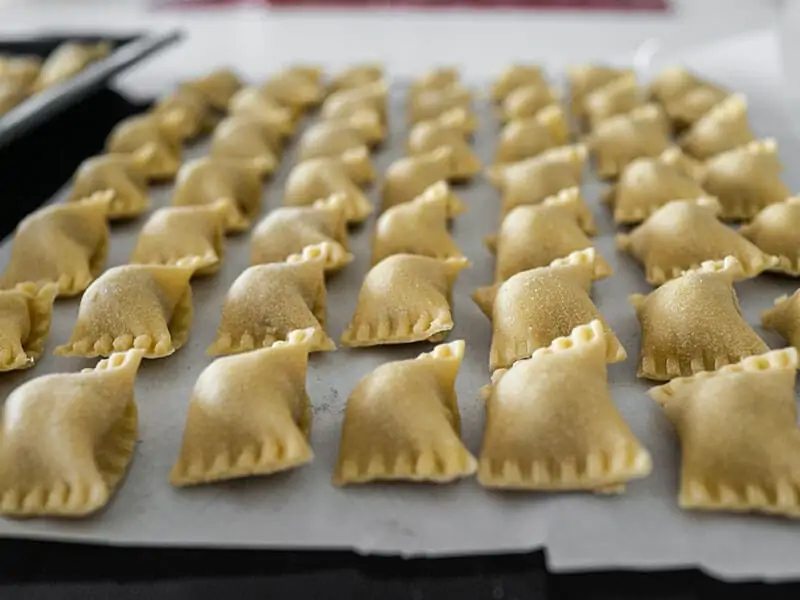
Filled with roasted meat or veggies, agnolotti is stuffed pasta in a square shape, making them very similar to ravioli. So please note that agnolotti uses 1 small piece of flat dough and folds over the filling, while ravioli asks for 2 pasta pieces to cover the filling.
If you find them in a rectangular form and smaller size, they are agnolotti al plin, and their filling is mostly made with meat.
The appropriate sauce to dress on this kind of pasta should be light because rich sauces might overpower the flavor of your agnolotti. Thus, beef broth of the mixture of sage leaves and melted butter are preferable.
27. Tortellini
Cooking time: 4 to 9 minutes
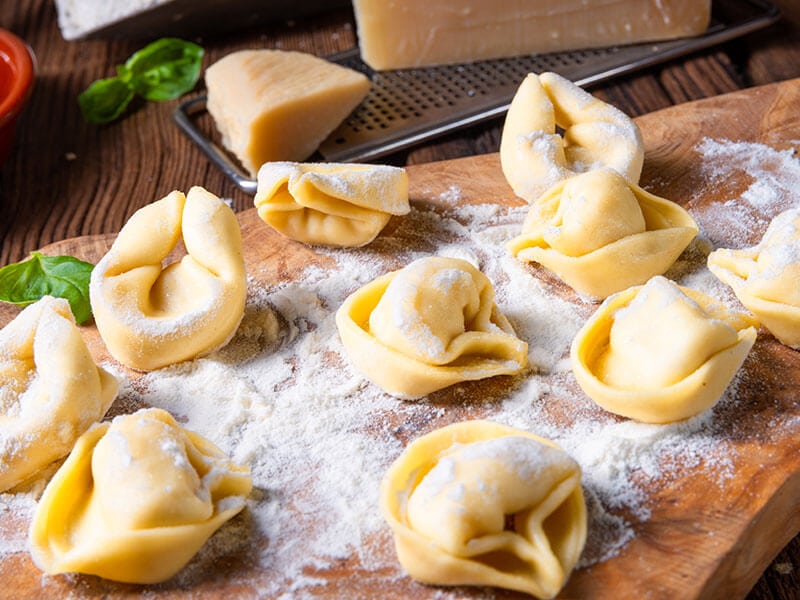
The last (but not least) stuffed pasta sort is tortellini. Until now, the true birthplace of tortellini is unclear as there are 2 cities in Italy claiming this pasta is their invention. But regardless of where they come from, tortellini look like small dumplings made from small circles of dough.
Of course, they are pasta with filling. Traditionally, the filling comprises minced meat (such as pork or sausage, like mortadella or prosciutto), cheese, spice, and egg.
Despite its complicated look, tortellini is good for homemade. But if you prefer store-bought ones, you can spot them in various forms, such as frozen, dried, or refrigerated.
To enjoy them at their finest, you should eat your tortellini with broth or creamy sauce. For cooking the pasta, you can boil tortellini in water or stir fry them.
Is it hard to make tortellini at home? Actually, it is not.
Soup Pasta Recipes
Soup pasta normally is small in size so it can work well in tons of Italian-themed soups. Many soup pasta falls under the pastina (small pasta) group. So if you seek ingredients to prepare a fun-yet-delicious soup for your kids (even you), below are 5 well-liked types.
28. Anelli
Cooking time: 7 to 10 minutes
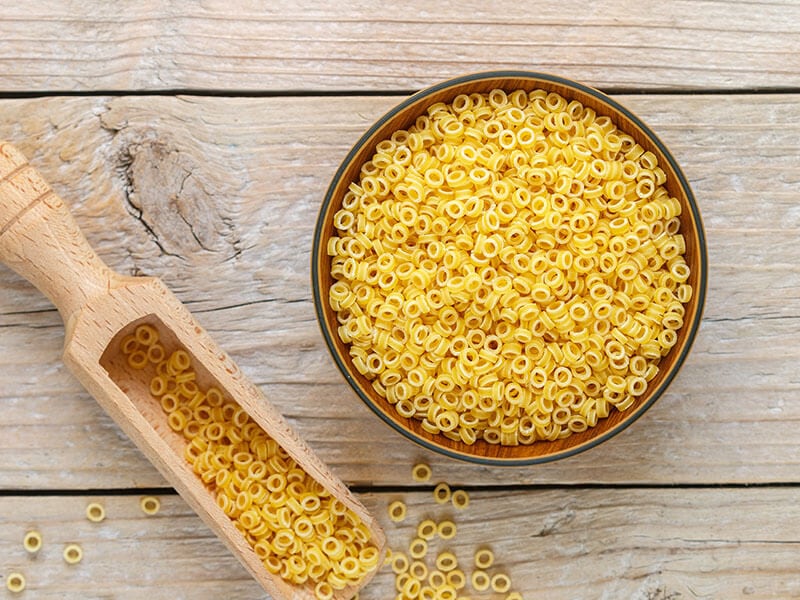
Anelli is a very small, thin pasta kind with a ring shape. In Italian, its name also means “ring” to imply the shape. There is a smaller version of it called anellini (meaning “little ring”) with 1/4 of the size of anelli.
Anelli shines perfectly in soups, salads, and even oven-baked recipes. You can also find them in some commercially canned soups or spaghetti, for example, Campbell’s Franco-American SpaghettiOs.
29. Ditalini
Cooking time: 8 to 10 minutes
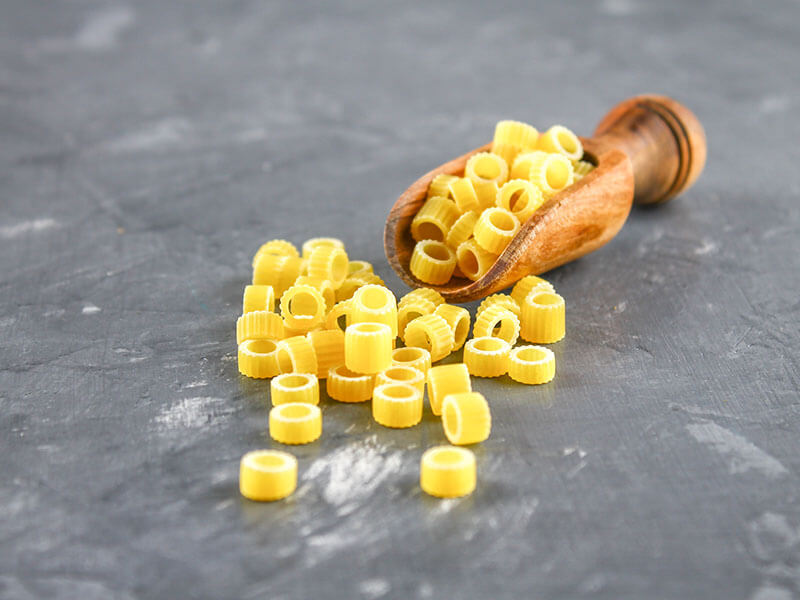
If you have traveled to Sicily, you might have seen this short-cut pasta that looks like small tubes on the local dining tables. It is Ditalini – a traditional food in many Sicilian delicacies.
People mostly use them for cooking soup. Furthermore, people in other areas also refer to them as “salad macaroni” because ditalini is also an ideal pasta for salad dishes.
This pasta also has a bigger version, which name is ditali, and has the same culinary purposes. Nowadays, they are mass-produced and sold around the world so you can quickly use them.
30. Stelle
Cooking time: About 5 to 7 minutes
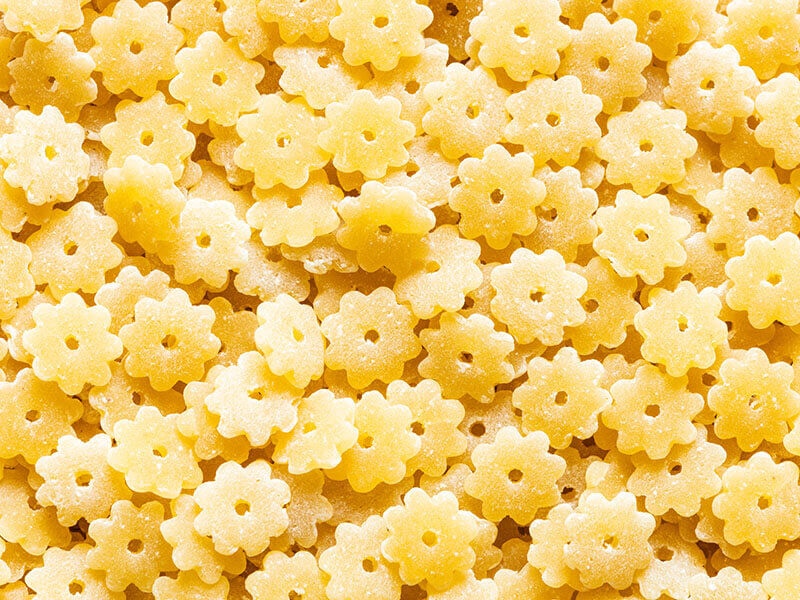
As a pasta under the pastini family, stelle is small pasta with the look of a star and a tiny hole in the center. Actually, the name of this pasta – stelle, is the plural form of “stelle”, which means “star” in Italian.
Though they are a small-sized type, their sizes vary with different names. For instance, stelloni is the biggest style, while Stellitine is smaller. But no matter what size they are, stelle is a fun twist in your soup, salads, and broths.
31. Orzo
Cooking time: 7 to 8 minutes
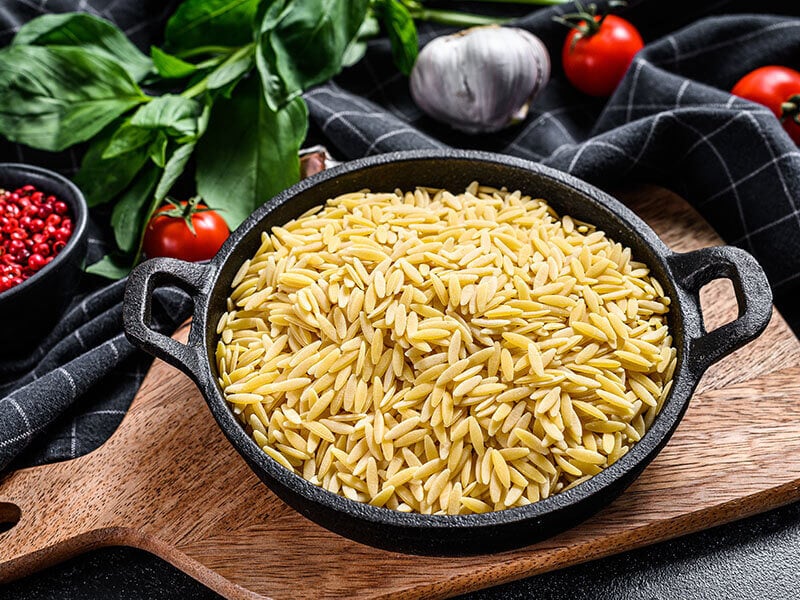
Orzo (aka risoni) is one of the smallest pasta that many people mistake for a rice grain. However, their texture is similar to other types because orzo comprises flour (or semolina, or whole grain) and water.
In Italian cuisine, people usually boil them in soup, like in minestrone soup. In fact, orzo is a versatile pasta that you can serve in many ways. They are good to enjoy alone, or in salads, casserole, or even fried dishes.
If you like pilaf – a rice dish with spices and broth, you can use orzo as a replacement for rice. Moreover, there are several tricks to color orzo by cooking with chilies, saffron, or black beans.
Check this detailed explanation to learn more about orzo.
32. Alphabet Pasta
Cooking time: 5 to 9 minutes
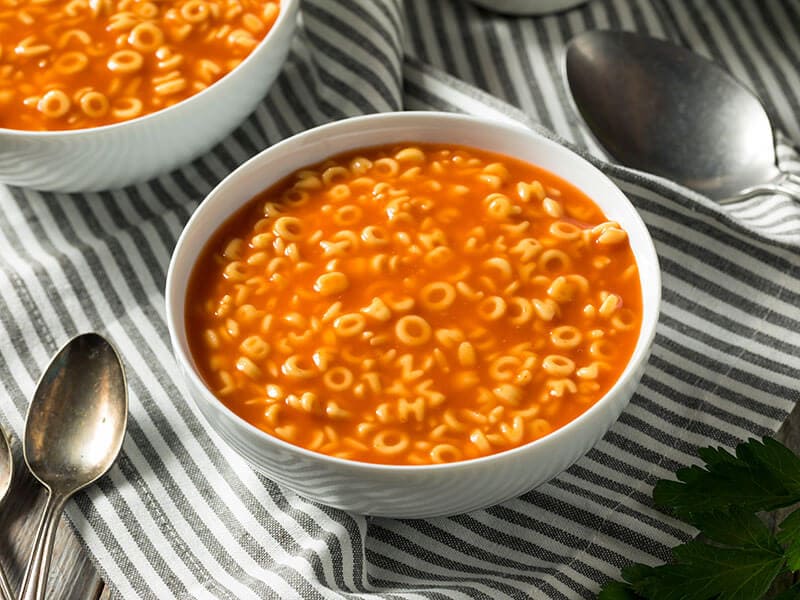
Alphabet pasta is not a new concept in the pasta world. The first reference to this variety can trace back to 1867 when some sellers tried to replace the regular macaroni with this alphabet-letter-shaped food.
Given the fact that alphabet pasta is fun food, they also offer educational value to teach your kids the alphabet during the meal. With various alphabet letters from A to Z, they are mostly available as commercial products which are pressed and produced by machine.
The typical treat to enjoy this pasta is alphabet soup, which can either be a homemade dish or store-bought condensed-style soup (e.g., Campbell’s brand soup). Besides soups, alphabet pasta is also suitable for serving in salads or mixed dishes.
What Are Stretched Pasta?
Stretched pasta refers to types of pasta that are crafted by stretching the dough, often by hand, over a wooden pasta board. This method gives them a distinctive texture and shape compared to other pasta types. 4 types of stretched pasta include:
33. Orecchiette
Cooking time: 9 to 12 minutes
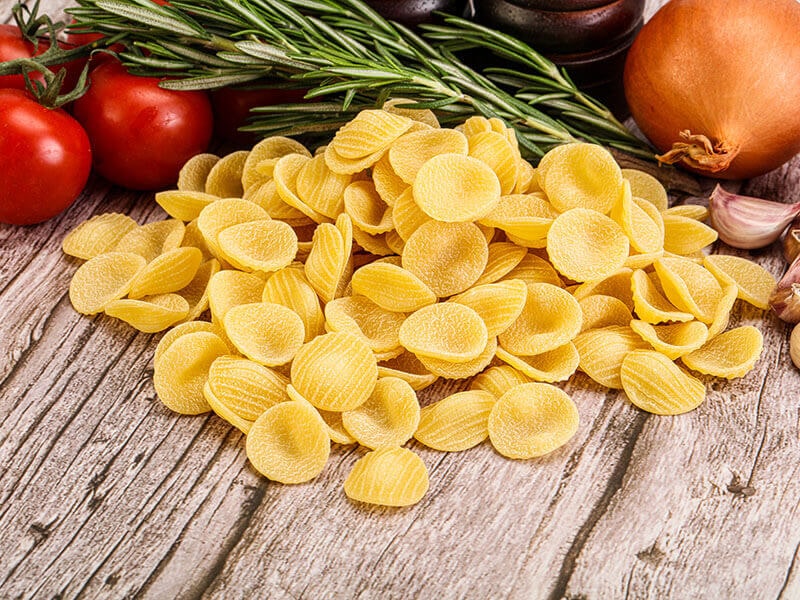
Orecchiette is a signature specialty from Apulia which owns a special shape that you can easily remember. At a quick glance, they look like little ears. That’s why they have this name that can translate to “small ear” in English.
For more specific, they have a dome-shaped appearance, in which the middle part is thinner than the rims. Their surface is rough so they can hold sauces, especially chunky sauces. You can pair it with bulky sauces made with various ingredients like cheese, meat, and veggies.
Water and durum wheat are the main things that make up this pasta. They are traditionally hand-made ones, but now you can also find the commercial orecchiette.
What are the secrets behind orecchiette? They are not only food, they are art.
34. Foglie D’ulivo
Cooking time: Around 5 to 10 minutes
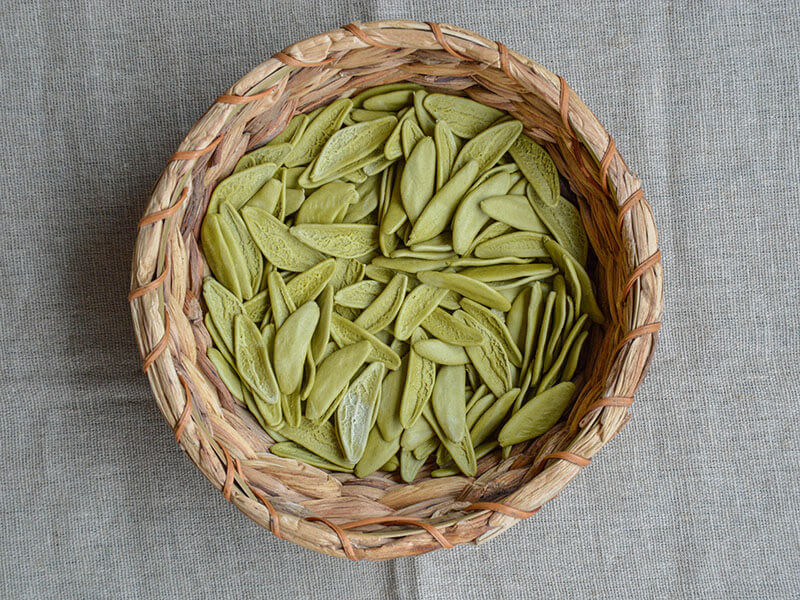
Here is another hand-made pasta type with a unique shape. Foglie D’ulivo, in Italian, means olive leaves, to resemble the appearance of this pasta. They come in 2 main colors: pale yellow (the basic color of pasta), and green (by using spinach extract) to mimic the real color of leaves.
You can prepare them at home. It might take some practice, but you will quickly know how to shape them correctly. Use your fingers, thumbs, and other kitchen tools to form a leaf-like shape.
The classic pairing of olive leaf pasta is with tomato sauce, but it is not wrong to enjoy it with thicker ones, like ragù. Foglie D’ulivo also makes an excellent addition to your salad or on its own with a bit of grated cheese and olive oil. Very flexible in use, isn’t it?
35. Cencioni
Cooking time: 4 to 5 minutes
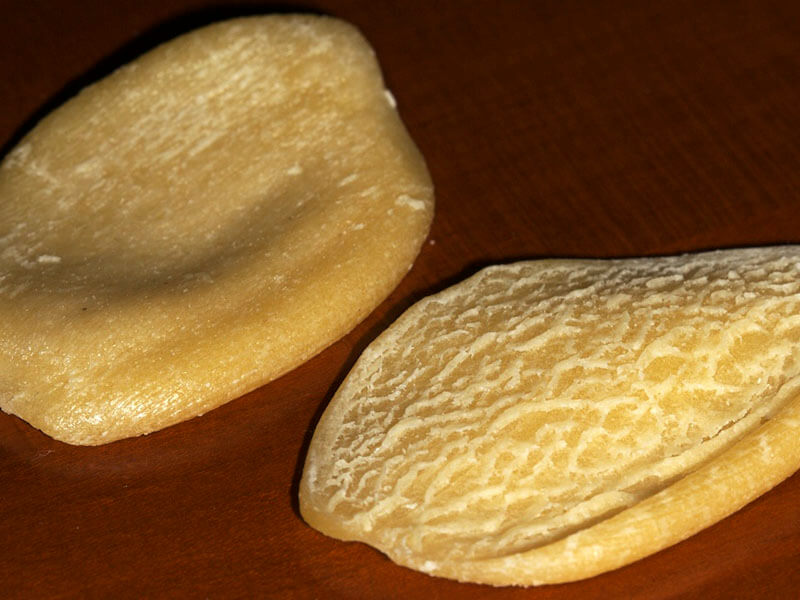
Cencioni (means “little rag” in Italian), is an oval-shaped (or petal-shaped) pasta with a rough surface on 1 side. Compared to orecchiette, this variant is slightly curved, flatter, and larger in size.
The components in cencioni are similar to other types, including water and durum wheat flour. As their shape is irregular, you do not need too many skills to recreate them yourself.
They have a nice chewy consistency to go with a variety of sauces (from thin to thick sauces) and salads.
36. Corzetti
Cooking time: About 4 minutes
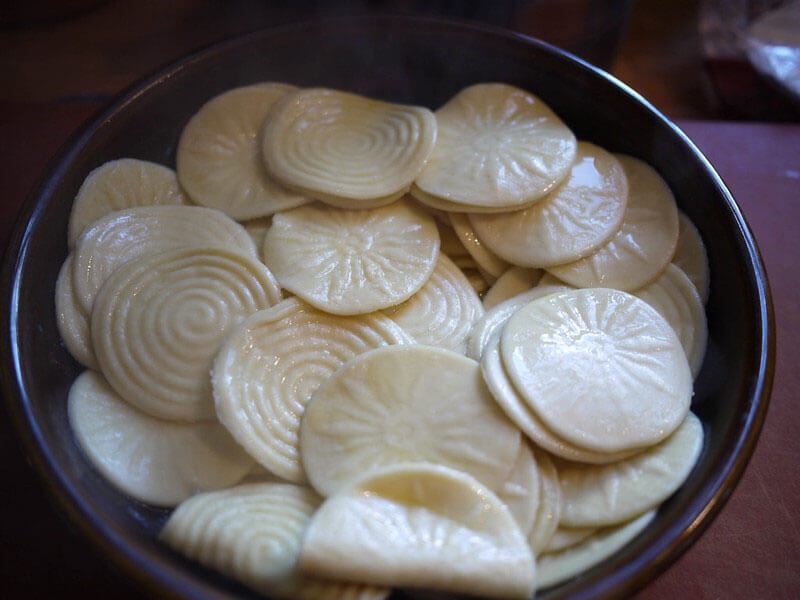
Corzetti is very attractive with the distinguishing pattern on their surface.
Let’s wrap this post with an ancient pasta with huge importance in Ligurian cuisine (in the North-west region of Italy). What makes Corzetti (aka Croxetti) stand out from the rest of the pasta here is its patterns on the surface.
Start with cutting the dough into flat circles (around 1 1/2 inches), then you can use a hand-stamped tool to create the pattern. So frankly, corzetti is a straightforward type of pasta for home-making.
The ideal companion of corzetti is pesto, mushroom, nut-based, or light cream sauces. If desired, you can consume it with meat as well.
Pasta – A Good Friend Of Everyone!
Pasta is an affordable food to prepare a lot of delicious meals. With the immense popularity not only in Italy but also in other countries, especially the United States, humans have chosen World Pasta Day on 25th October.
As a staple food in many households, it is crucial to learn some special pasta varieties so you can make a better choice in making tasty dishes. Therefore, I hope this post has covered enough information to differentiate and choose the appropriate pasta.
Lastly, please rate the article below and share it with others if you find the article helpful. If there are other concerns about these 35 sorts of pasta, you can leave your comment in the box. Thank you for your support.
